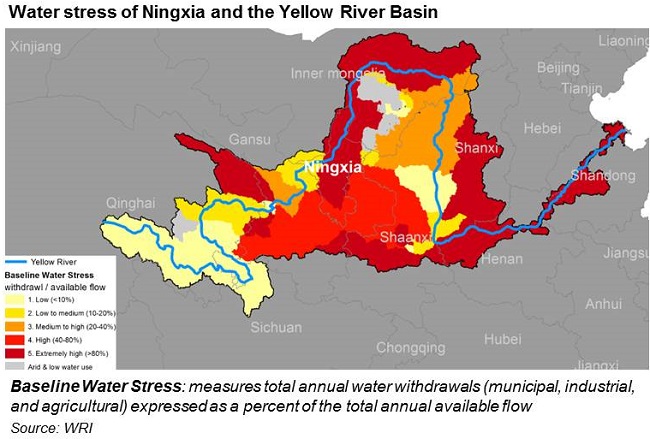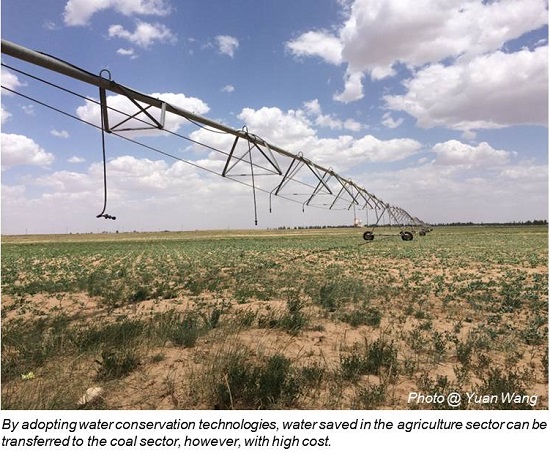The Complex Relationship and Looming Crisis Between Our Thirst For Water and Our Hunger for Energy
November 11th, 2015
Courtesy of China Water Risk, a detailed look at how how Ningxia (China) manages water for coal & shares strategies to reduce future water stress:
Highlights
- Ningxia is water-stressed and home to a large coal base
- Coal contributes 50% of industrial output; but 91.5% coal fired installed cap in high water-stressed regions
- From 2004 to 2012, 80mn cum agri water saving transferred to coal projects through water rights trading
WRI recenlty published the report “Water Risk Analysis and Recommendations for Water Resources Management in Ningxia”. For this report WRI partnered with China Water Risk and the Ningxia Development Research Center. The report analysed water resources profiles, water resources management, and current water use patterns in Ningxia province, China. WRI’s Aqueduct Water Risk Framework and Map tool was used to assess the baseline water stress of Ningxia with a focus on Ningxia’s coal industry. A closer look was taken at the development of the coal industry and its impact on water resources. The report also provides suggestions for the management of Ningxia’s water resources whilst developing coal.
Ningxia is one of the most water-stressed regions in China, with per capita water resources just 30 percent of the national average and over 70 percent of the land subjected to high to extremely high water stress, according to WRI’s Aqueduct Water Risk Atlas.
Ningxia is one of the most water-stressed regions in China, with per capita water resources just 30% of the national average
Although Ningxia is one of the smallest provinces in China, it is home to one of China’s largest coal bases, Ningdong Energy and Chemical Industry Base (“Ningdong base” below). Coal production and power generation has driven Ningxia’s economy over the past decade. However, as an extremely thirsty industry, coal has put more stress on the area’s water supply and heightened competition with other users, including farms and households.
Coal production and power generation, though thirsty, has driven Ningxia’s economy over the past decade
A WRI working paper recommends developing a coordinated system to ensure sustainable development of water and the economy in Ningxia.
Coal drives Ningxia’s GDP but also exposes the province to water risk
Ningxia’s coal industry made up around 50 percent of total industrial production in 2012 and helped drive a tripling of GDP per capita between 2005 and 2012.
However, such rapid coal development exacerbated water stress. By the end of 2012, 91.5 percent of installed power capacity of Ningxia’s coal fired power plants was in areas with acute water shortage (see below).
By 2012 91.5% of installed capacity of coal fired power plants was in areas with acute water shortage
Water consumption will grow 2x by 2020 compared to 2010 levels if targets are met at the Ningdong base
Even though power plants using air cooling technologies, which reduce water consumption, accounted for 62.8 percent of the total installed capacity, new planned coal-fired power plants will still increase water demand. Estimates by WRI suggest that water consumption will rise 1.5 times by 2015 and double by 2020 compared to 2010 levels if coal fired power generation targets are met at the Ningdong base.
Ningxia has 5 prefecture-level cities: Yinchuan, Shizuishan, Zhongwei, Wuzhong and Guyuan which are shown in Figure 2.
Policy and economic changes to deal with coal’s thirsty water demands in Ningxia
Ningxia provincial government has adopted policies and implemented economic measures to meet the coal industry’s high demand for water; including water conservation, water rights transfer and water pricing measures. Increased investment in water-saving technologies cut Ningxia’s water consumption per RMB10,000 of GDP by 77 percent, and industrial water consumption per RMB10,000 industrial value added by 68 percent from 2004 to 2012. During the same period, about 88 mn m3 of water were transferred to nine coal projects through water right transfers.
However, these measures’ effectiveness can be further improved, especially through investments the efficiency of agricultural water use. Agriculture accounts for 90 percent of Ningxia’s total water withdrawal, most of it flood irrigation, but the province’s agricultural water use efficiency is 6 percent lower than the national average. The government has proposed transferring water from agriculture to coal production, but there are limitations given the existing canal infrastructure. At the same time, funding is limited and farmers are not able to move to water-saving farming methods without additional financing.
Local govt has proposed transferring water from agri to coal production. But agri water use efficiency is 6 % lower than national average
Current policies treat water & energy separately, not recognising that they are inextricably linked
Meanwhile, Ningxia’s current water rates and water resources fees are too low to reflect the real value of water, weakening incentives to conserve this vital resource. In addition, current policies treat water and energy as separate elements in Ningxia, not recognising that they are inextricably linked.
5 ways Ningxia could coordinate sustainable coal and water development
To ensure sustainable development of the coal sector and water resources in Ningxia, WRI’s recommends:
- Recognising that water is a finite resource and needs to be seriously considered when planning coal development. Given the scarcity of water and the growing demand for it from cities and industries and for food production, it makes sense to increase non-coal energy and energy efficiency investments.
- Improving agricultural water efficiency. Our analysis estimated 0.34 bn m3 of water could be saved by increasing agriculture water use efficiency from 45 percent (Ningxia 2012 value) to 51 percent (China 2012 value). Regardless of coal development inefficient agricultural water is needed for other sectors and to support Ningxia’s growing economy.
- Developing a robust water rights allocation and trading system between companies and farmers or within companies with safeguards to protect farmers but also promote more efficient water use.
- Accelerating water price reform. Raising water resources fees and exploiting price leverage to encourage conservation.
- Setting up a system of eco-compensation for the coal and mining sector using incentives – such as subsidies and tax exemptions, and policy supports to encourage the mining industry to protect and restore natural areas that can improve water quality and water supplies.
This entry was posted on Wednesday, November 11th, 2015 at 10:33 pm and is filed under Uncategorized. You can follow any responses to this entry through the RSS 2.0 feed. You can leave a response, or trackback from your own site.
Leave a Reply
You must be logged in to post a comment.
Educated at Yale University (Bachelor of Arts - History) and Harvard (Master in Public Policy - International Development), Monty Simus has held a lifelong interest in environmental and conservation issues, primarily as they relate to freshwater scarcity, renewable energy, and national park policy. Working from a water-scarce base in Las Vegas with his wife and son, he is the founder of Water Politics, an organization dedicated to the identification and analysis of geopolitical water issues arising from the world’s growing and vast water deficits, and is also a co-founder of SmartMarkets, an eco-preneurial venture that applies web 2.0 technology and online social networking innovations to motivate energy & water conservation. He previously worked for an independent power producer in Central Asia; co-authored an article appearing in the Summer 2010 issue of the Tulane Environmental Law Journal, titled: “The Water Ethic: The Inexorable Birth Of A Certain Alienable Right”; and authored an article appearing in the inaugural issue of Johns Hopkins University's Global Water Magazine in July 2010 titled: “H2Own: The Water Ethic and an Equitable Market for the Exchange of Individual Water Efficiency Credits.”



